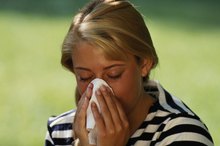Oak Pollen Allergy Symptoms
Spring brings leaves to the oak trees and sends oak pollen into the air, causing millions of allergy sufferers to reach for the antihistamines and tissue. Oak trees normally pollinate in March, April and May, with more pollen appearing in the early morning hours. During this time, daily reports of the pollen count can help allergy sufferers recognize when their symptoms might worsen. Oak pollen allergy symptoms are similar to other pollen allergies. While most symptoms of oak pollen allergies are mild and self-limiting, serious allergic reactions can occur.
If you are experiencing serious medical symptoms, seek emergency treatment immediately.
Rhinitis
Hay fever, also known as allergic rhinitis, is the term used to describe the typical mild but annoying allergic reaction to oak pollen. Hay fever symptoms include sneezing, watery, swollen and itchy eyes, runny nose and cough. The throat and nose may itch, and nosebleeds may occur. Some allergy sufferers develop dark circles under their eyes called allergic shiners. Children often develop an allergic salute -- an upward swipe of the palm of the hand to rub the nose.
Treatments for hay fever symptoms include antihistamines, eye drops and decongestants. Immunotherapy, also known as allergy shots, helps desensitize an allergic person to the substance, which reduces symptoms. Staying indoors when oak pollen counts are high, using a HEPA air filter inside to remove particles from the air, keeping the windows closed and changing clothes immediately after spending time outside when the oak pollen count rises all help reduce symptoms.
- Hay fever, also known as allergic rhinitis, is the term used to describe the typical mild but annoying allergic reaction to oak pollen.
- Immunotherapy, also known as allergy shots, helps desensitize an allergic person to the substance, which reduces symptoms.
Airway Constriction
Allergy to Bee Pollen & Allergy to Beeswax
Learn More
Oak pollen allergies can cause asthma symptoms in susceptible people 3. Asthma causes constriction or narrowing of the bronchial tubes that carry air into the lungs. Symptoms include:
- shortness of breath
- tightness or pain in the chest
- rapid heart rate
- coughing
- wheezing
- difficulty sleeping
Serious asthma attacks can be life-threatening if the airways narrow so much that enough air does not enter the lungs. People with asthma from oak pollen allergy, even if it occurs only seasonally, need medical evaluation and treatment with bronchodilators and possibly corticosteroids to reduce swelling in the airways.
- Oak pollen allergies can cause asthma symptoms in susceptible people 3.
- Symptoms include: * shortness of breath
* tightness or pain in the chest
* rapid heart rate
* coughing
* wheezing
* difficulty sleeping Serious asthma attacks can be life-threatening if the airways narrow so much that enough air does not enter the lungs.
Fatigue and Sinus Problems
Allergy to oak pollen can also cause fatigue, headache or feelings of pain or pressure in the sinuses or a decrease in the ability to taste or smell. Some people suffer a temporary partial hearing loss when symptoms are severe.
Related Articles
References
- Asthma and Allergy Foundation of America: Pollens and Mold Counts
- U.S. Environmental Protection Agency: Projecting Pollen Allergens and their Health Implications in a Changing World
- Allergy, Asthma & Clinical Immunology: Tree Pollen Allergy in Southwestern Ontario
- Asthma and Allergy Foundation of America. Pollen Allergies.
- Dellavalle CT, Triche EW, Leaderer BP, Bell ML. Effects of ambient pollen concentrations on frequency and severity of asthma symptoms among asthmatic children. Epidemiology. 2012;23(1):55-63. doi:10.1097/EDE.0b013e31823b66b8
- Handa S, De D, Mahajan R. Airborne contact dermatitis - current perspectives in etiopathogenesis and management. Indian J Dermatol. 2011;56(6):700-6. doi:10.4103/0019-5154.91832
- Texas MedClinic. Symptoms and Remedies for Cedar Fever.
- Portelli MA, Hodge E, Sayers I. Genetic risk factors for the development of allergic disease identified by genome-wide association. Clin Exp Allergy. 2015;45(1):21-31. doi:10.1111/cea.12327
- The American Academy of Allergy, Asthma & Immunology. SLIT Treatment for Allergic Rhinitis Nothing to Sneeze About.
- Oral allergy syndrome (OAS). The American Academy of Allergy, Asthma & Immunology.
- Gao Z, Huang M, Qu Z, Wang J, Cai X.Identification of DNA methylation module in seasonal allergic rhinitis.Int J Pediatr Otorhinolaryngol. 2019 Feb;117:163-166. doi: 10.1016/j.ijporl.2018.11.030. Epub 2018 Nov 29.
- Maya-Manzano JM, Sadyś M, Tormo-Molina R, Fernández-Rodríguez S, Oteros J, Silva-Palacios I, Gonzalo-Garijo A.Relationships between airborne pollen grains, wind direction and land cover using GIS and circular statistics.Sci Total Environ. 2017 Apr 15;584-585:603-613. doi: 10.1016/j.scitotenv.2017.01.085. Epub 2017 Jan 27.
Writer Bio
A registered nurse with more than 25 years of experience in oncology, labor/delivery, neonatal intensive care, infertility and ophthalmology, Sharon Perkins has also coauthored and edited numerous health books for the Wiley "Dummies" series. Perkins also has extensive experience working in home health with medically fragile pediatric patients.







